Lior Wolf
Execution Guided Line-by-Line Code Generation
Jun 12, 2025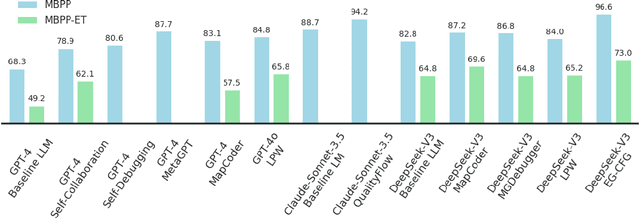
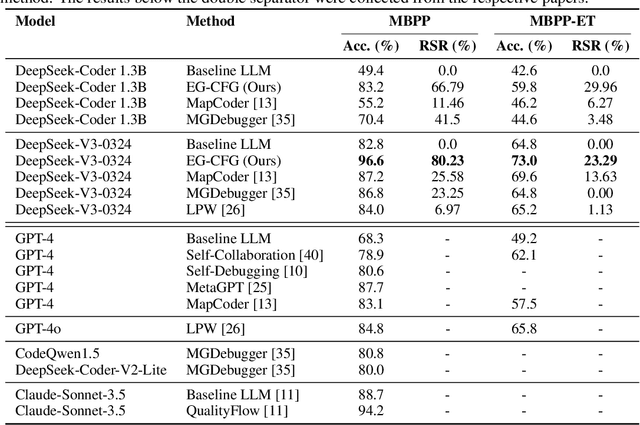
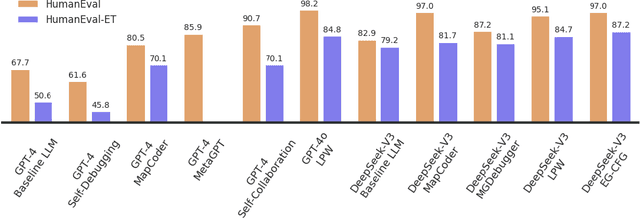
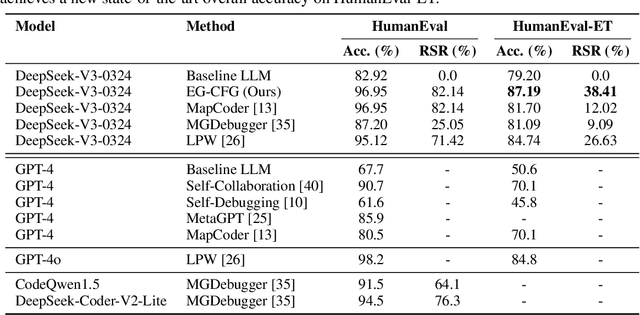
Abstract:We present a novel approach to neural code generation that incorporates real-time execution signals into the language model generation process. While large language models (LLMs) have demonstrated impressive code generation capabilities, they typically do not utilize execution feedback during inference, a critical signal that human programmers regularly leverage. Our method, Execution-Guided Classifier-Free Guidance (EG-CFG), dynamically incorporates execution signals as the model generates code, providing line-by-line feedback that guides the generation process toward executable solutions. EG-CFG employs a multi-stage process: first, we conduct beam search to sample candidate program completions for each line; second, we extract execution signals by executing these candidates against test cases; and finally, we incorporate these signals into the prompt during generation. By maintaining consistent signals across tokens within the same line and refreshing signals at line boundaries, our approach provides coherent guidance while preserving syntactic structure. Moreover, the method naturally supports native parallelism at the task level in which multiple agents operate in parallel, exploring diverse reasoning paths and collectively generating a broad set of candidate solutions. Our experiments across diverse coding tasks demonstrate that EG-CFG significantly improves code generation performance compared to standard approaches, achieving state-of-the-art results across various levels of complexity, from foundational problems to challenging competitive programming tasks. Our code is available at: https://github.com/boazlavon/eg_cfg
Overclocking LLM Reasoning: Monitoring and Controlling Thinking Path Lengths in LLMs
Jun 08, 2025Abstract:Recently, techniques such as explicit structured reasoning have demonstrated strong test-time scaling behavior by enforcing a separation between the model's internal "thinking" process and the final response. A key factor influencing answer quality in this setting is the length of the thinking stage. When the reasoning is too short, the model may fail to capture the complexity of the task. Conversely, when it is too long, the model may overthink, leading to unnecessary computation and degraded performance. This paper explores and exploits the underlying mechanisms by which LLMs understand and regulate the length of their reasoning during explicit thought processes. First, we show that LLMs encode their progress through the reasoning process and introduce an interactive progress bar visualization, which is then used to reveal insights on the model's planning dynamics. Second, we manipulate the internal progress encoding during inference to reduce unnecessary steps and generate a more concise and decisive chain of thoughts. Our empirical results demonstrate that this "overclocking" method mitigates overthinking, improves answer accuracy, and reduces inference latency. Our code is publicly available.
ConsiStyle: Style Diversity in Training-Free Consistent T2I Generation
May 27, 2025Abstract:In text-to-image models, consistent character generation is the task of achieving text alignment while maintaining the subject's appearance across different prompts. However, since style and appearance are often entangled, the existing methods struggle to preserve consistent subject characteristics while adhering to varying style prompts. Current approaches for consistent text-to-image generation typically rely on large-scale fine-tuning on curated image sets or per-subject optimization, which either fail to generalize across prompts or do not align well with textual descriptions. Meanwhile, training-free methods often fail to maintain subject consistency across different styles. In this work, we introduce a training-free method that achieves both style alignment and subject consistency. The attention matrices are manipulated such that Queries and Keys are obtained from the anchor image(s) that are used to define the subject, while the Values are imported from a parallel copy that is not subject-anchored. Additionally, cross-image components are added to the self-attention mechanism by expanding the Key and Value matrices. To do without shifting from the target style, we align the statistics of the Value matrices. As is demonstrated in a comprehensive battery of qualitative and quantitative experiments, our method effectively decouples style from subject appearance and enables faithful generation of text-aligned images with consistent characters across diverse styles.
IlluSign: Illustrating Sign Language Videos by Leveraging the Attention Mechanism
Apr 15, 2025Abstract:Sign languages are dynamic visual languages that involve hand gestures, in combination with non manual elements such as facial expressions. While video recordings of sign language are commonly used for education and documentation, the dynamic nature of signs can make it challenging to study them in detail, especially for new learners and educators. This work aims to convert sign language video footage into static illustrations, which serve as an additional educational resource to complement video content. This process is usually done by an artist, and is therefore quite costly. We propose a method that illustrates sign language videos by leveraging generative models' ability to understand both the semantic and geometric aspects of images. Our approach focuses on transferring a sketch like illustration style to video footage of sign language, combining the start and end frames of a sign into a single illustration, and using arrows to highlight the hand's direction and motion. While many style transfer methods address domain adaptation at varying levels of abstraction, applying a sketch like style to sign languages, especially for hand gestures and facial expressions, poses a significant challenge. To tackle this, we intervene in the denoising process of a diffusion model, injecting style as keys and values into high resolution attention layers, and fusing geometric information from the image and edges as queries. For the final illustration, we use the attention mechanism to combine the attention weights from both the start and end illustrations, resulting in a soft combination. Our method offers a cost effective solution for generating sign language illustrations at inference time, addressing the lack of such resources in educational materials.
A Meaningful Perturbation Metric for Evaluating Explainability Methods
Apr 09, 2025Abstract:Deep neural networks (DNNs) have demonstrated remarkable success, yet their wide adoption is often hindered by their opaque decision-making. To address this, attribution methods have been proposed to assign relevance values to each part of the input. However, different methods often produce entirely different relevance maps, necessitating the development of standardized metrics to evaluate them. Typically, such evaluation is performed through perturbation, wherein high- or low-relevance regions of the input image are manipulated to examine the change in prediction. In this work, we introduce a novel approach, which harnesses image generation models to perform targeted perturbation. Specifically, we focus on inpainting only the high-relevance pixels of an input image to modify the model's predictions while preserving image fidelity. This is in contrast to existing approaches, which often produce out-of-distribution modifications, leading to unreliable results. Through extensive experiments, we demonstrate the effectiveness of our approach in generating meaningful rankings across a wide range of models and attribution methods. Crucially, we establish that the ranking produced by our metric exhibits significantly higher correlation with human preferences compared to existing approaches, underscoring its potential for enhancing interpretability in DNNs.
Adapting to the Unknown: Training-Free Audio-Visual Event Perception with Dynamic Thresholds
Mar 21, 2025Abstract:In the domain of audio-visual event perception, which focuses on the temporal localization and classification of events across distinct modalities (audio and visual), existing approaches are constrained by the vocabulary available in their training data. This limitation significantly impedes their capacity to generalize to novel, unseen event categories. Furthermore, the annotation process for this task is labor-intensive, requiring extensive manual labeling across modalities and temporal segments, limiting the scalability of current methods. Current state-of-the-art models ignore the shifts in event distributions over time, reducing their ability to adjust to changing video dynamics. Additionally, previous methods rely on late fusion to combine audio and visual information. While straightforward, this approach results in a significant loss of multimodal interactions. To address these challenges, we propose Audio-Visual Adaptive Video Analysis ($\text{AV}^2\text{A}$), a model-agnostic approach that requires no further training and integrates a score-level fusion technique to retain richer multimodal interactions. $\text{AV}^2\text{A}$ also includes a within-video label shift algorithm, leveraging input video data and predictions from prior frames to dynamically adjust event distributions for subsequent frames. Moreover, we present the first training-free, open-vocabulary baseline for audio-visual event perception, demonstrating that $\text{AV}^2\text{A}$ achieves substantial improvements over naive training-free baselines. We demonstrate the effectiveness of $\text{AV}^2\text{A}$ on both zero-shot and weakly-supervised state-of-the-art methods, achieving notable improvements in performance metrics over existing approaches.
On the Expressivity of Selective State-Space Layers: A Multivariate Polynomial Approach
Feb 04, 2025



Abstract:Recent advances in efficient sequence modeling have introduced selective state-space layers, a key component of the Mamba architecture, which have demonstrated remarkable success in a wide range of NLP and vision tasks. While Mamba's empirical performance has matched or surpassed SoTA transformers on such diverse benchmarks, the theoretical foundations underlying its powerful representational capabilities remain less explored. In this work, we investigate the expressivity of selective state-space layers using multivariate polynomials, and prove that they surpass linear transformers in expressiveness. Consequently, our findings reveal that Mamba offers superior representational power over linear attention-based models for long sequences, while not sacrificing their generalization. Our theoretical insights are validated by a comprehensive set of empirical experiments on various datasets.
VideoJAM: Joint Appearance-Motion Representations for Enhanced Motion Generation in Video Models
Feb 04, 2025Abstract:Despite tremendous recent progress, generative video models still struggle to capture real-world motion, dynamics, and physics. We show that this limitation arises from the conventional pixel reconstruction objective, which biases models toward appearance fidelity at the expense of motion coherence. To address this, we introduce VideoJAM, a novel framework that instills an effective motion prior to video generators, by encouraging the model to learn a joint appearance-motion representation. VideoJAM is composed of two complementary units. During training, we extend the objective to predict both the generated pixels and their corresponding motion from a single learned representation. During inference, we introduce Inner-Guidance, a mechanism that steers the generation toward coherent motion by leveraging the model's own evolving motion prediction as a dynamic guidance signal. Notably, our framework can be applied to any video model with minimal adaptations, requiring no modifications to the training data or scaling of the model. VideoJAM achieves state-of-the-art performance in motion coherence, surpassing highly competitive proprietary models while also enhancing the perceived visual quality of the generations. These findings emphasize that appearance and motion can be complementary and, when effectively integrated, enhance both the visual quality and the coherence of video generation. Project website: https://hila-chefer.github.io/videojam-paper.github.io/
Deep Active Speech Cancellation with Multi-Band Mamba Network
Feb 03, 2025Abstract:We present a novel deep learning network for Active Speech Cancellation (ASC), advancing beyond Active Noise Cancellation (ANC) methods by effectively canceling both noise and speech signals. The proposed Multi-Band Mamba architecture segments input audio into distinct frequency bands, enabling precise anti-signal generation and improved phase alignment across frequencies. Additionally, we introduce an optimization-driven loss function that provides near-optimal supervisory signals for anti-signal generation. Experimental results demonstrate substantial performance gains, achieving up to 7.2dB improvement in ANC scenarios and 6.2dB in ASC, significantly outperforming existing methods. Audio samples are available at https://mishalydev.github.io/DeepASC-Demo
Classifier-Guided Captioning Across Modalities
Jan 03, 2025
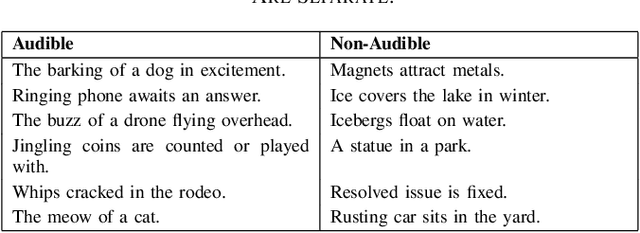


Abstract:Most current captioning systems use language models trained on data from specific settings, such as image-based captioning via Amazon Mechanical Turk, limiting their ability to generalize to other modality distributions and contexts. This limitation hinders performance in tasks like audio or video captioning, where different semantic cues are needed. Addressing this challenge is crucial for creating more adaptable and versatile captioning frameworks applicable across diverse real-world contexts. In this work, we introduce a method to adapt captioning networks to the semantics of alternative settings, such as capturing audibility in audio captioning, where it is crucial to describe sounds and their sources. Our framework consists of two main components: (i) a frozen captioning system incorporating a language model (LM), and (ii) a text classifier that guides the captioning system. The classifier is trained on a dataset automatically generated by GPT-4, using tailored prompts specifically designed to enhance key aspects of the generated captions. Importantly, the framework operates solely during inference, eliminating the need for further training of the underlying captioning model. We evaluate the framework on various models and modalities, with a focus on audio captioning, and report promising results. Notably, when combined with an existing zero-shot audio captioning system, our framework improves its quality and sets state-of-the-art performance in zero-shot audio captioning.
 Add to Chrome
Add to Chrome Add to Firefox
Add to Firefox Add to Edge
Add to Edge